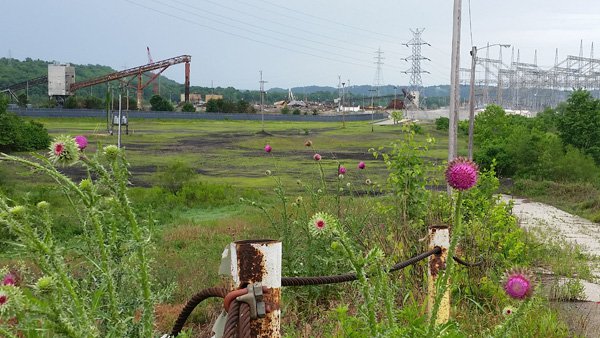The Hoosier Environmental Council is advocating for fly ash stored at the former Tanners Creek Power Plant to be excavated and relocated before it impacts local drinking water.

Tanners Creek Power Plant site. File photo.
(Lawrenceburg, Ind.) – It is not a question of if, but perhaps when local drinking water will be contaminated by millions of tons of coal ash at the former Tanners Creek Power Plant site in Lawrenceburg.
“In every one of these impoundments, there is damage being done to the groundwater underneath them,” Hoosier Environmental Council senior policy director Tim Maloney told local concerned citizens at the Lawrenceburg Public Library on Tuesday.
The Hoosier Environmental Council, a non-profit started in 1983 to shape policy on environmental quality in Indiana, says Indiana’s 86 coal combustion residual impoundments number more than any other state. At 17 of Indiana’s power plant sites where coal ash is stored, there has been confirmed groundwater contamination.
Those 17 sites include Tanners Creek, where American Electric Power operated a coal burning plant until 2015. Most of the coal ash byproduct was stored on-site in a series of landfills built up over 50 years.
 “There is coal ash widespread throughout that property,” said Maloney, whose organization was among four who wrote to the Indiana Department Environmental Management last year urging the agency to reject Tanners Creek Development’s ash pond closure plans.
“There is coal ash widespread throughout that property,” said Maloney, whose organization was among four who wrote to the Indiana Department Environmental Management last year urging the agency to reject Tanners Creek Development’s ash pond closure plans.
Tanners Creek Development, LLC, a brownfield redevelopment company and subsidiary of Commercial Development Company, owns the 725-acre property. They are preparing it for potential redevelopment as Indiana’s fourth inland port. Ports of Indiana is currently in a purchase agreement which has been extended through mid-2019.
The town hall meeting was organized by Beverly Millspaugh, a Greendale resident who has been keeping tabs on the environmental remediation and safety of the aquifer just below the surface of the site. She and others peppered Maloney with questions throughout his presentation.
Tanners Creek Development submitted revised ash pond closure plans to IDEM last August. In December, the department notified the company that it would need more information and changes to the plans. IDEM cited the U.S. Court of Appeals in Washington, D.C.’s August ruling that both active and closed, or legacy, fly ash impoundments must be subject to the same EPA rules.
Maloney said the federal rule does allow ash ponds to be closed in place, but there must be assurances that the harmful material will not come in contact with groundwater. In the cases of ash ponds at Tanners Creek, the bottom of the ash layer is already penetrating several feet into the underground water aquifer.
“Covering an unlined surface lagoon does not stop contamination from happening underneath,” Maloney said, citing the fluctuation in the level of the water table. “The concept of closing in place is fraught with so many problems.”
The potential for flooding of the nearby Ohio River also calls into question the safety of the ash ponds.
Maloney referred citizens to a report completed in December by ATC Group Services, LLC. Contracted by Ports of Indiana, the environmental consulting firm took a close look at the ash and groundwater situations at Tanners Creek. Soil borings found fly ash going as deep as 40 feet below the surface - even deeper than believed by IDEM inspectors who issued violations last fall.
View the 237-page ATC Group Services, LLC report here (PDF, 31.5 MB).
Groundwater testing from monitoring wells surrounding the ash landfills at Tanners Creek has determined there are multiple contaminants over U.S. EPA drinking water standards. They include arsenic and manganese. The boron level of 1.56 mg/L, is below the EPA's recommended limit of 3.0 mg/L, but still higher than is normally found in groundwater other places.
Drinking water wellfields for Aurora Utilities and LMS Conservancy are located just northwest of the ash ponds. Maloney noted that contaminants have not been found at dangerous levels in water pulled from those wells.
That could change in the future. He displayed hydrological studies finding that groundwater is, at times, flowing from beneath the ash areas toward those wells.
Aurora Utilities superintendent Randy Turner was among those in attendance for Maloney’s presentation. He said no contaminants are currently being found in excessive levels in its drinking water.
“The impact will be ongoing for as long as we’re able to use the wells,” Turner said, adding that the utility is being proactive with its water testing and remaining vigilant.
“We’ve not seen any evidence that the drinking water supplies are exceeding the standards. Not in the raw water or certainly in the treated water,” Maloney agreed.
Maloney said Tanners Creek Development’s closure plan is to monitor the ash ponds for 30 years after their closure. But what about beyond then?
“Is that an acceptable risk or not when you’re talking about a community’s drinking water supply?” he asked.
Maloney said the Hoosier Environmental Council is advocating for the excavation and relocation of the fly ash to a location where it will not impact water quality and human health. That solution could, perhaps, be the most cost-effective.
Utility companies in Indiana, Georgia, South Carolina are digging up old ash ponds and moved into modern, better-engineered landfills where they pose less risk.
“There is still an environmental risk, but it is much less,” Maloney said. “It’s not an ideal solution, but better than what is happening now to simply cover it up and leave it where it is.”
Maloney is hopeful that IDEM will require Tanners Creek Development to take some action beside closing the ash ponds in place. That method, he said, won’t be able to meet performance standards set by the federal rule now applied to inactive ash impoundments.
But the Tanners Creek property ever being transformed into a pristine, contaminant-free site may not be a reasonable expectation. IDEM’s risk-based approach means that some contamination could be left there.
The Hoosier Environmental Council is not taking a position on Ports of Indiana’s proposal to establish a port at Tanners Creek, said Maloney. He did note that capping the ash ponds in place could limit redevelopment opportunities there.
Dearborn County Councilman Bill Ullrich was one of two elected officials at the meeting. He told the town hall that he has heard from state level that Indiana's governor wants the port to happen, but also wants the site cleaned up right.
Greendale City Councilman Scott Libbert was also in attendance and asked about Greendale’s developed area filled with fly ash. Maloney commented that for many years, using ash for fill was legal and unregulated in Indiana. Using the ash for fill comes with same risks as other surface impoundments, he added.
RELATED STORIES:
Fly Ash Town Hall On The Calendar
IDEM Finds Large Amounts Of Fly Ash In Unpermitted Areas Of Tanners Creek Plant Site
Ports Of Indiana, Tanners Creek Development Extend Purchase Agreement
IDEM: Lawrenceburg Ash Pond Closure Plan On Hold As Federal Cases Linger
Public Hearing For Tanners Creek Ash Pond Closure Plan Could Happen Oct. 11
Environmental Groups Urge IDEM To Deny Revised Fly Ash Pond Closure Plan
Tanners Creek Development, IDEM Answer Citizens On Fly Ash, Groundwater
After Out-Of-State Fly Ash Halted, Questions Over What's Already In The Ground At Tanners Creek

 UPDATE: Pavement Rehabilitation Work Continues on U.S. 50 in Aurora
UPDATE: Pavement Rehabilitation Work Continues on U.S. 50 in Aurora
 TRAC Green Lights Funding Dry Fork Road Widening Project
TRAC Green Lights Funding Dry Fork Road Widening Project
 Death Investigation Underway After Body of Madison Woman is Found in Carroll Co.
Death Investigation Underway After Body of Madison Woman is Found in Carroll Co.
 ISDA Offers Planting Season Road Safety Tips
ISDA Offers Planting Season Road Safety Tips
 Riverbend Announces Clear Bag Policy for Upcoming Season
Riverbend Announces Clear Bag Policy for Upcoming Season
 Rolling Roadblocks Today on I-71 in Carroll, Gallatin Counties
Rolling Roadblocks Today on I-71 in Carroll, Gallatin Counties











